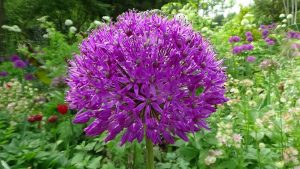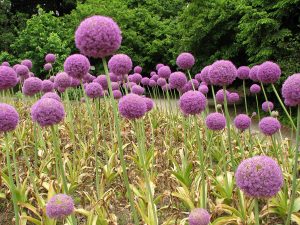The large plant genus allium includes edible onions, garlic, shallots, and leeks but it also includes a vast group of perennial ornamental flowers that are both showy and easy to grow. Allium’s flower colors are most commonly blues and purples, but some are white or yellow. Allium plants produce chemical compounds that give them a characteristic onion or garlic taste and odor. Because of this strong, oniony scent, alliums are largely deer and rodent resistant, a huge plus for those of us with deer and voles in our yards.
 Alliums originated in central Asia—they are grown mostly in temperate climates. By the time Linnaeus was classifying plants in 1753 he gave allium its name; “allium” is the Latin word for garlic. Linnaeus described 30 species of allium.
Alliums originated in central Asia—they are grown mostly in temperate climates. By the time Linnaeus was classifying plants in 1753 he gave allium its name; “allium” is the Latin word for garlic. Linnaeus described 30 species of allium.
Cultivation
 Most alliums grow from bulbs that need to be planted in the fall in a sunny spot with well-drained soil. Alliums have few insect and disease problems. Use odd-numbered groups of 3, 5 or more; a single flower will look lonely. For the best effect, plant large quantities of a dozen or more of the shorter allium species, such as yellow Allium moly. Small allium bulbs should be planted three to four inches deep; giant allium about eight inches, but, remember, if bulbs are planted too deeply, they will not bloom properly. A general rule for planting depth of all bulbs is dig a hole three times the depth of the bulb.
Most alliums grow from bulbs that need to be planted in the fall in a sunny spot with well-drained soil. Alliums have few insect and disease problems. Use odd-numbered groups of 3, 5 or more; a single flower will look lonely. For the best effect, plant large quantities of a dozen or more of the shorter allium species, such as yellow Allium moly. Small allium bulbs should be planted three to four inches deep; giant allium about eight inches, but, remember, if bulbs are planted too deeply, they will not bloom properly. A general rule for planting depth of all bulbs is dig a hole three times the depth of the bulb.
Deadhead spent flowers before they develop seeds to help strengthen blooms the following year. Allium seldom need dividing, but if you want to amend your soil or move them, do so in the fall. As with tulips and other bulbs, let the foliage die back before cutting it off to allow nutrients to be transported to the bulbs and stored for next season’s growth. Cut back on watering your allium when the leaves start to turn yellow. To help hide their dying foliage, plant them next to later-blooming perennials with plenty of foliage such as rudbeckia, hardy geraniums, or false sunflowers.
Check out the chart for some favorite alliums. And be ready to plant these easy-to-grow perennial bulbs next fall!
